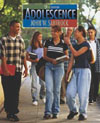John W. Santrock,
University of Texas, Dallas
| adolescence | The developmental period of transition from childhood to early adulthood; it involves biological, cognitive, and socioemotional changes.
|
 |
 |
 |
| adolescent generalization gap | Adelson's concept of widespread generalizations about adolescents based on information about a limited, highly visible group of adolescents.
|
 |
 |
 |
| biological processes | Changes in an individual's physical nature and appearance.
|
 |
 |
 |
| cognitive processes | Changes in an individual's thinking and intelligence.
|
 |
 |
 |
| contexts | Settings in which development occurs. These settings are influenced by historical, economic, social, and cultural factors.
|
 |
 |
 |
| continuity-discontinuity issue | Continuity is the gradual, cumulative change from conception to death. Discontinuity is development progressing through distinct stages in the life span.
|
 |
 |
 |
| development | The pattern of change that begins at conception and continues through the life cycle. Most development involves growth, although it also includes decay (as in death and dying).
|
 |
 |
 |
| early adolescence | The developmental period that corresponds roughly to the middle school or junior high school years and includes most pubertal change.
|
 |
 |
 |
| early adulthood | The developmental period beginning in the late teens or early twenties and lasting into the thirties.
|
 |
 |
 |
| early childhood | The developmental period extending from the end of infancy to about 5 or 6 years of age; sometimes called the preschool years.
|
 |
 |
 |
| early-later experience issue | This issue focuses on the degree to which early experiences (especially early in childhood) or later experiences are the key determinants of development.
|
 |
 |
 |
| generational inequity | The unfair treatment of younger members of an aging society in which older adults pile up advantage by receiving inequitably large allocations of resources, such as Social Security and Medicare.
|
 |
 |
 |
| infancy | The developmental period that extends from birth to 18 or 24 months.
|
 |
 |
 |
| inventionist view | The view that adolescence is a sociohistorical creation. Especially important in this view are the sociohistorical circumstances at the beginning of the twentieth century, a time when legislation was enacted that ensured the dependency of youth and made their move into the economic sphere more manageable.
|
 |
 |
 |
| late adolescence | Approximately the latter half of the second decade of life. Career interests, dating, and identity exploration are often more pronounced in late adolescence than in early adolescence.
|
 |
 |
 |
| late adulthood | The developmental period that lasts from about 60 to 70 years of age until death.
|
 |
 |
 |
| middle adulthood | The developmental period that is entered at about 35 to 45 years and exited at about 55 to 65 years of age.
|
 |
 |
 |
| middle and late childhood | The developmental period extending from about 6 to about 10 or 11 years of age; sometimes called the elementary school years.
|
 |
 |
 |
| nature-nurture issue | Nature refers to an organism's biological inheritance, nurture to environmental experiences. "Nature" proponents claim that biological inheritance is the most important influence on development; "nurture" proponents claim that environmental experiences are the most important.
|
 |
 |
 |
| prenatal period | The time from conception to birth.
|
 |
 |
 |
| social policy | A national government's course of action designed to influence the welfare of its citizens.
|
 |
 |
 |
| socioemotional processes | Changes in an individual's relationships with other people, emotions, personality, and social contexts.
|
 |
 |
 |
| stereotype | A broad category that reflects our impressions and beliefs about people. All stereotypes refer to an image of what the typical member of a particular group is like.
|
 |
 |
 |
| storm-and-stress view | G. Stanley Hall's concept that adolescence is a turbulent time charge with conflict and mood swings.
|
 |
 |
 |
| youth | Kenniston's term for the transitional period between adolescence and adulthood that is a time of economic and personal temporariness.
|



 2003 McGraw-Hill Higher Education
2003 McGraw-Hill Higher Education

 2003 McGraw-Hill Higher Education
2003 McGraw-Hill Higher Education